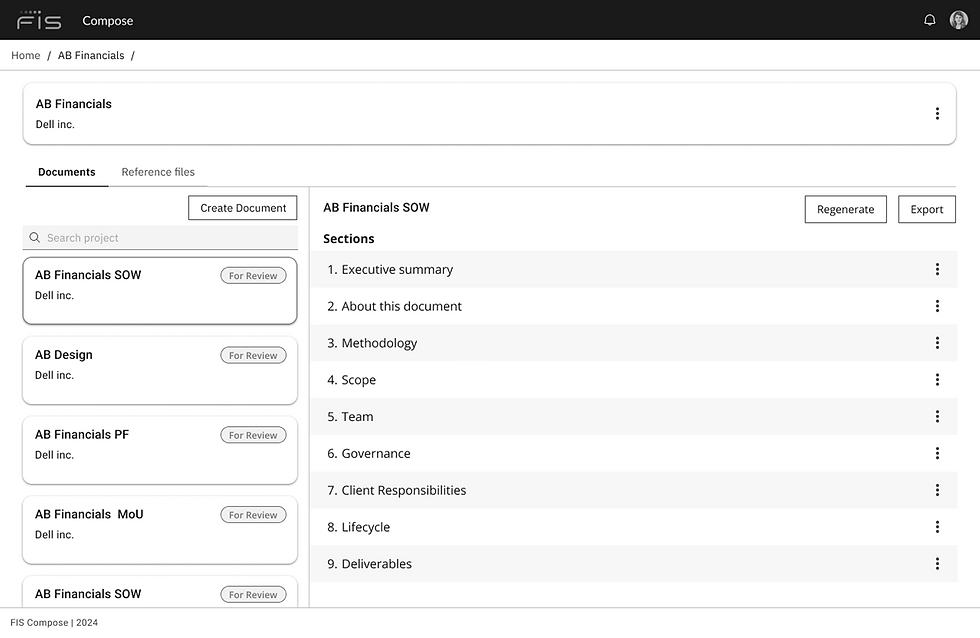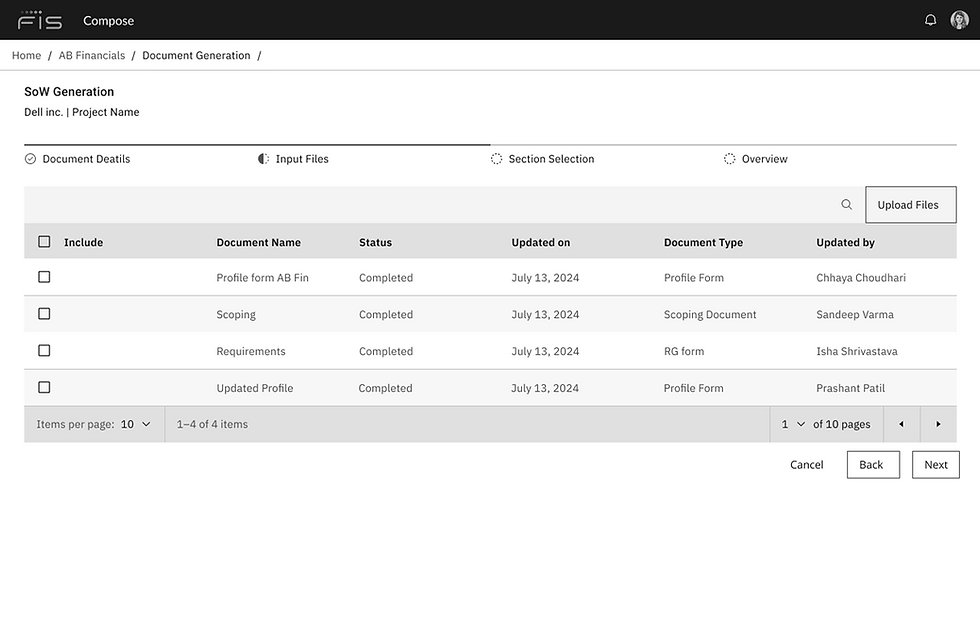
Compose | AI-powered documentation
Introduction
Compose is an internal AI-powered documentation platform designed to simplify and accelerate technical documentation for FIS Capital Markets products. It empowers product, engineering, and support teams to generate, manage, and collaborate on documentation using natural language, improving both efficiency and content accuracy.
As the Design Lead, I was responsible for defining the end-to-end user experience, from understanding complex user needs to designing scalable, intuitive interfaces that seamlessly integrate AI assistance into daily workflows.
The Challenge
Creating documentation manuals for FIS products was time-consuming, error-prone, and inconsistent across teams. Even with predefined templates, users had to manually scan through multiple documents to locate relevant information and fill in details correctly. Each client provided data and requirements in different formats, which made content standardisation difficult.
This led to:
- Slower document creation,
-
Inconsistent output quality and error error-prone process
-
Delays in client onboarding due to manual validation and review cycles.
The goal was to streamline and automate documentation, bringing structure, speed, and accuracy through AI while retaining user control and contextual awareness.
Research & Insights
Through stakeholder interviews and shadowing documentation teams, we identified key challenges:
-
Manual aggregation: Users had to refer to multiple scattered sources and legacy systems to compile information.
-
Inconsistent templates: Different product lines used unique document formats, causing confusion and duplication.
-
High error rate: Manual data entry increased the likelihood of inconsistencies and rework.
-
Onboarding delays: The entire documentation cycle added friction to the client onboarding process.
These insights formed the foundation for our problem statement:
“How might we enable documentation teams to generate accurate, standardised, and error-free manuals faster, while reducing the cognitive load of manual search and formatting?”
Design Strategy
We envisioned Compose as an AI-assisted co-author.
a system that helps users create high-quality documentation without the overhead of manual referencing or formatting.
-
Introduced AI-driven data extraction to pull relevant content from existing documents.
-
Designed a guided documentation flow that reduces dependency on memory and manual lookup.
-
Implemented smart templates that adapt dynamically based on client context.
-
Human-in-the-loop editing: AI-generated drafts were always editable, balancing automation with human oversight.
-
Scalable design and architecture: Designed flexibly enough to support multiple document types, future AI models and other enterprise app integrations.
-
Instrumentation: Transparent metrics (time saved, cost per token, document revisions) helped leadership justify ROI.

AI Integration
AI in Compose was built around trust, transparency, and control.
-
The editor blends AI-enabled inline editing with familiar text formatting tools, so users can refine content naturally.
-
Each generated section includes sources and references inline, eliminating the need to open multiple documents for verification.
-
For advanced users, data retrieval hints and prompt suggestions are visible upfront, offering insight into how AI interprets context. Prompts can also be edited at the section level for finer control.
-
Features like “Explain” and “Source” provide transparency into AI-generated content, helping users understand not just what was written, but why and where it came from.
This made Compose’s AI assistive, explainable, and reliable, amplifying human efficiency without sacrificing trust.
User profiles and actions

Agile way of working
Focused on three critical flows
-
Document creation: guiding users from project inputs → AI-assisted drafts → editable final documents.
-
User management: ensuring secure role-based access for teams and clients.
-
App governance: enabling admins to track costs, monitor usage, and maintain compliance
Iterative approach
-
Research foundation: The UX research team collected insights from legal and documentation teams, which became the basis for feature prioritisation.
-
Tech-design synergy: While the tech team trained the generative AI models, the design team iterated on key flows to ensure usability and trust.
-
Prototyping & validation: We tested early prototypes internally, rapidly integrating feedback before moving to production.
Sample wireframe




Document generation flow

Outcome & Impact

Pilot Success
43 users onboarded, 10 projects created, with reduced documentation effort from nearly four hours to just minutes.

Efficiency Gains
Saving about $900 per project, or around $9,000 total in the pilot.

Strategic ROI
While many of the AI projects failed to show ROI, FIS Compose proved a rare success, delivering measurable business value and earning recognition.
Reflection & Learnings
-
Strategic AI adoption works best when paired with UX discipline, grounding every feature in real pain points.
-
Fail-fast doesn’t mean compromise: Tight deadlines forced us to design lean, but we ensured that every interaction delivered value.
-
Trust is the currency of AI products: Giving users control to edit, regenerate, and monitor costs builds confidence in the system.